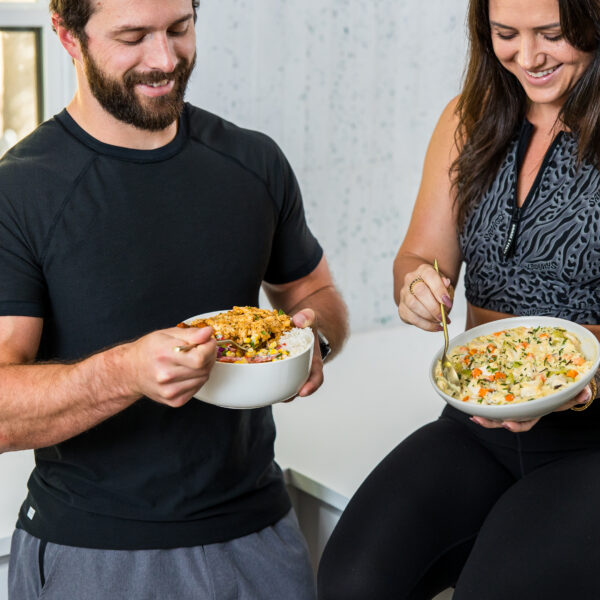You’ve probably heard that breakfast is the most important meal of the day, or that you should eat lots of small mini-meals throughout the day to boost your metabolism. Not only is this somewhat outdated advice, but there’s a new trend in town that’s flipping conventional nutrition advice on its head. Today, our lead RD Sam is breaking down the what, the why and the how to help you figure out if intermittent fasting is right for you.
what is intermittent fasting?
Intermittent fasting (IF) involved a shortened eating window. With IF, you’re not necessarily changing what you eat, but just when you’re eating. While most people benefit most from IF if they’re eating a low carb or ketogenic diet since they’re already fat burners, you can certainly play around with it if you’re eating a moderate to high carb diet and see how you feel.
The most popular version of IF is a 16-8, meaning that you fast for 16 hours and eat in an 8-hour window. Here’s how it might work: you eat dinner at 7 pm, but don’t break your fast until 11 am. Some choose to skip dinner instead, for example having an eating window of 7 am-3 pm. For most people, this is harder to follow and stick with.
Some other fasting methods include:
- 24-hour water fast: you guessed it! Fast for 24 hours and only drink water.
- a 24-hour bone broth fast: In this version, you fast for 24 hours with bone broth as your only source of calories/nutrients.
- a 24-hour fat fast: with a fat fast, you can consume pure fat (for example MCT oil or butter in your coffee, but nothing else.
- 5:2 method: eat normally 5 days a week, and decrease calories to 500-600 for the remaining 2 days.
- alternate-day fasting: eat normally one day, then fast the next on a rotating schedule.
- the warrior diet: fast all day and then have one large meal at night.
While people have varying success with all of these methods, many of them are somewhat extreme and not the best place to start. We’ll talk about the best way to get started with IF below.
what are the benefits?
There are quite a few researched benefits of intermittent fasting, and most of them boil down to a few key things: lower insulin levels & increased insulin sensitivity, and increased autophagy. Let’s break it down.
LOWER INSULIN LEVELS & INCREASED INSULIN SENSITIVITY
When you’re in the fed (i.e. not fasted) state, your pancreas secretes insulin in reaction to the food you eat, predominantly for carbohydrates and to a lesser degree for proteins. Insulin is a hormone that tells your body’s cells to absorb the glucose floating around in your blood. It’s a storage hormone that stimulates the production of body fat when produced in excess in response to excess food consumption.
Walking around with a high level of insulin on the sporadic occasion is one thing, but if it’s happening on the reg, it can get ugly. Enter insulin insensitivity. Basically, the more insulin your body produces, the less adept your cells are at dealing with it. You become insulin resistant, which can lead to other health conditions like pre-diabetes or type 2 diabetes.
By fasting, or decreasing the amount of time you spend in the fed or insulin-secreting state, you lower overall blood levels of glucose and insulin. Instead of utilizing glucose for fuel, you teach your body to use other stores of energy, like body fat. And by managing lower overall insulin levels, you’re also helping your cells stay sensitive to its effects when you are in the fed state.
INCREASED AUTOPHAGY
Although you’ve probably never heard of autophagy, it’s a super cool mechanism in the body. Think of it as your biology’s very own recycling system. The rate of autophagy is boosted by the low insulin levels associated with IF. During autophagy, our cells cannibalize themselves, eating up damaged, old and otherwise less than awesome cells, and using their parts to regenerate new ones. I know it sounds weird and gross, but it’s actually good for you. Autophagy helps control inflammation, boosts immunity, and slows down aging.
how do you get started?
You can’t “out-fast” a bad diet, so the following suggestions come under the overarching assumption that when you’re not fasting, you’re eating mostly whole foods and lots of veggies. Think of a plate with veggies, high-quality protein, and healthy fats. If you’ve got that on lock and want to see if some tweaks here and there help you feel/look/perform better, here’s how I’d recommend you get started.
Start slow! Your new IF routine can take some getting used to and it can be tough on some women hormonally, so don’t try to go all-in during your first week. Try fasting for 12 hours a day just a couple times a week. Gradually increase your fasting days and/or your hours fasting and keep tabs on how you’re feeling. You can even increase your fasting time by 30 minutes every few weeks. Slow and steady, friends! Remember that even if you eventually get to the point where you’re fasting regularly, you still don’t have to fast every day to see results. A few times a week will still reap plenty of benefits!
If you’re having trouble with the fast due to hunger or a lack of mental clarity, sipping on a coffee with MCT oil may help get you to the 12+ hour mark. While there’s some debate about fat fasts, since the MCT oil is all fat, so it won’t spike your insulin. It’s also been shown to help your body’s production of ketone bodies, which will help you feel energized and focused along with the caffeine from the coffee. With this method, you won’t get the benefit of autophagy but you’ll still get the other benefits of fasting.
And if the hunger is really getting to you, check in with your intake by logging in MyFitnessPal for a day or two. You may not be getting enough calories in during the day to keep you satisfied through your fast. Remember, IF isn’t about crazy caloric restriction.
And if, after all that, you can’t get down with IF, move on with your life! There are so many ways to be healthy, and this is just one of them. There’s something for everyone, but there’s no one approach that works for all. Don’t force your body to practice IF if it simply isn’t working for you.
Are you interested in trying IF? Are you already successfully using Snap Kitchen? Let us know in the comments!





Leave a Reply
No Comments